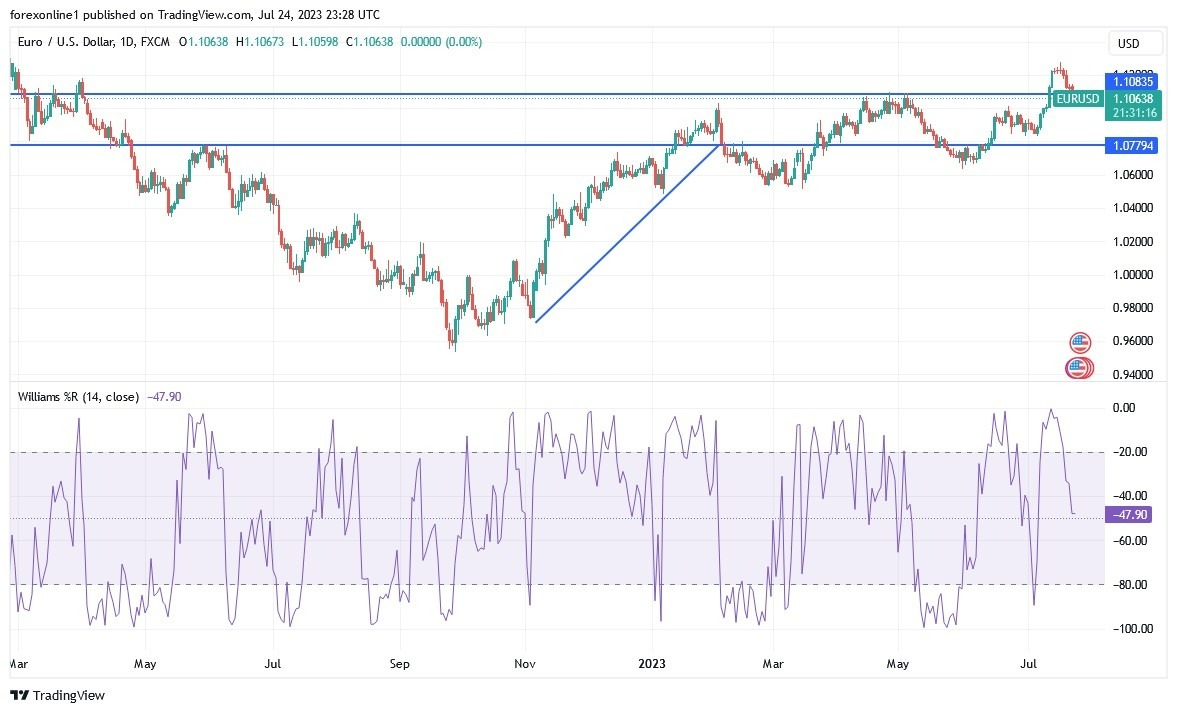The EUR/USD exchange rate entered the new week's trading under pressure and is likely to be at risk of deeper losses if the hawkish US Federal Reserve statement on Wednesday is followed by a more dovish update of the European Central Bank's (ECB) monetary policy on Thursday and more indications of a deteriorating continental economy. The losses of the EUR/USD currency pair extended at the beginning of this week's trading, towards the 1.1060 support level, the lowest for the currency pair two weeks ago, and the currency pair stabilizes around those losses.
Top Forex Brokers
The single European currency fell back towards its mid-month lows on Monday, in a partial unwinding of its recent rally after S&P global purchasing managers' index surveys indicated that output from the euro zone's manufacturing and service sectors fell at its fastest pace for eight months in July.
Commenting on this, Forex analysts at Societe Generale stated that “Needless to say, this is not beneficial, and the dollar is stronger against both the euro and the yen, as we await the big events of this week – the FOMC on Wednesday, the European Central Bank on Thursday, and the Bank of Japan on Friday.”
"There are no prizes for realizing that a market with large long-term European data and weak European data will need a lot of help from US data to avoid capitulating some trades," they added.
According to official announcements, France witnessed the most noticeable declines in the indicated economic output this month while the German economy also faltered. However, in what could have been a consolation for the members of the European Central Bank's Governing Council, inflation pressures were also reported to have eased significantly in Europe this month.
All in all, the price component of Monday's reports may partly offset last Thursday's Eurostat figures containing an upward revision of the eurozone's core inflation rate from 5.4% to 5.5% in July, which seemed to complicate the ECB's task on Thursday.
Accordingly, Salomon Fiedler, an economist at Berenberg, said regarding yesterday's polls that “For the European Central Bank before the monetary policy meeting on Thursday, the reading is mostly pessimistic. Continued moderation in domestic demand will reduce pricing power and contribute to weaker price pressures.”
Governing members are widely expected to raise the once-negative European Central Bank deposit rate to 3.75% on Thursday, but some other policymakers and economists have begun to suggest over the past week or even that another hike in September is no longer a foregone conclusion.
Yesterday's polls were the latest in a growing string of private and official indicators pointing to an accelerating slowdown in the eurozone economy but come at a time when a relatively stronger US economy and a more hawkish US Federal Reserve loom large. In general, economists, analysts and financial markets expect the Fed to raise the US interest rate from 5.25% to 5.5% on Wednesday, but it has stopped pricing in the additional rise to 5.75% likely indicated in the June outlook update, so the dollar and the euro may be sensitive tomorrow, Wednesday, to any indications of whether these expectations are still valid.
EUR/USD Technical Outlook
- According to the performance on the daily chart below, the general trend of the EUR/USD currency pair is still turning bearish, and the bears' control over the trend will strengthen if the currency pair's price stabilizes below the psychological level of 1.1000.
- Which may bring the bears more momentum to move down strongly and change the pair's general direction to bearish.
On the other hand, and for the same time period, and as I mentioned before, the 1.1250 resistance will remain the most important for the bulls to control the direction. I expect the EUR/USD pair to remain around the current pressure until the reaction to the policy decisions of both the Federal Reserve Bank and the European Central Bank.
 Ready to trade our Forex daily forecast? We’ve shortlisted the best currency trading platforms in the industry for you.
Ready to trade our Forex daily forecast? We’ve shortlisted the best currency trading platforms in the industry for you.
